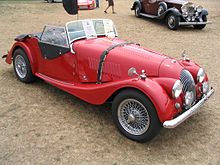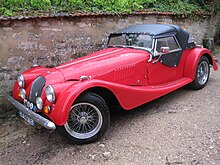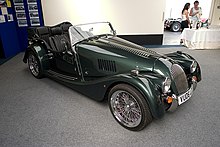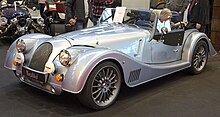Morgan engine
| Morgan Motor Company
|
|
|---|---|
| legal form | Limited |
| founding | 1909 |
| Seat | Malvern , Worcestershire , West Midlands |
| management | Harry Frederick Stanley Morgan (Founder), Charles Morgan since 1999 |
| Number of employees | 200 |
| sales | £ 33.8m (€ 39m ) |
| Branch | Automotive industry |
| Website | [1] |
The Morgan Motor Company is a British car manufacturer for sports cars in private hands. The company is the only one in the world that still uses bodies with frames made of ash wood for automobiles , a production technique that stems from the manufacture of coaches . The Morgan 4/4 holds the record as the longest continuously produced car model. The very light and sometimes very powerful vehicles from Morgan have cult status in a large fan base. Around 1000 vehicles are built every year; Germany is Morgan's second largest market; total sales are around 48 million euros.
history
The company was founded in 1909 by Harry Frederick Stanley Morgan (* 1881 in Stoke Lacy Rectory, Hereford , † 1959) in Malvern Link, a suburb of Malvern in the county of Worcestershire , West Midlands , was founded. After the founder's death in 1959, his son Peter took over the management. Peter Morgan died on October 20, 2003. His son Charles has been running the company since 1999.
In 2009, the Morgan Motor Company celebrated its 100th anniversary with numerous events in Malvern Link and Cheltenham between July 24th and August 2nd. A total of 75,000 vehicles were built. Today there is a factory museum and around 25,000 visitors annually.
In April 2019, the Italian investor Investindustrial (which also has a stake in Aston Martin ) took over the majority of the company.
Three-wheeler
Initially, three-wheeled vehicles were built, with an engine and two steered wheels at the front and one driven rear wheel. The weight of the first three wheeler was given as 178 kg. Over the years, a large number of variants have been built: "simple" two-seater, also four-seater and delivery vans with box bodies . Until 1934 there were only air or water-cooled two - cylinder built -in engines from various manufacturers. The JAP motors are known , but also motors from Matchless and Anzani . Often the engines were installed freely in the airstream in front of the front axle, others had a hood or the engine behind the radiator.
There were also sports and racing versions . For example, a three-wheeler on the reached in 1928 Brooklands - racetrack h a top speed of 180 km /. From 1934 the F series was added with a different body shape, which was also produced as a two-seater, four-seater and a sports version. "F" stands for the Ford engine used, a four-cylinder in - line engine . In 1952 the production of the Morgan three-wheeler was ended.
Morgan Threewheeler at Retro Classics 2018
Morgan 4/4, Plus 4, Plus 4 Plus
The first prototype of the four-wheeled automobile was tested in 1935. Series production of the 4/4 model (four-cylinder, four wheels), which was initially called the 4-4, began in 1936. This model is still being built today, modified a little, but conceptually unchanged. Mainly more modern engines and transmissions were installed again and again when the model was changed so that the vehicle could comply with the applicable laws and approval regulations. The 4/4 is the longest series-production vehicle in the world to this day.
The so-called Drophead Coupé was an independent body shape, built from 1938 to 1968. It was characterized by the windshield with a rigid window frame, the folding top firmly mounted on the body, raised doors with fixed window frames and sliding panes. This model was also built in different versions: as a 4/4, +4, 4-4, and a four-seater drophead coupe ("coupé with removable roof", according to the German understanding of a convertible , more comfortable than a roadster ) was in 52 or 53 copies built.
In 2009, the 4/4 Sport, a purist variant, came onto the market with the 82 kW (112 PS) 1.6-liter engine from Ford and costing around 39,500 euros with further simplified equipment.
The first model with a fixed roof was the Morgan Plus 4 Plus from 1963 , which was only built 26 times. It has a body made of glass fiber reinforced plastic on the traditional platform, in keeping with contemporary tastes.
+8 / plus eight
1969 as a second series of +8 (or plus 8) with the originally Buick developed Rover - eight-cylinder - V-engine introduced with a displacement of 3.5 liters and a power of about 120 kW (160 hp). With a vehicle weight of 935 kg (curb weight), the driving performance was very good for that time. In terms of acceleration , it was able to keep up with most sports cars until the end. Because of the not very sporty engine (31 kW / l), the car has good pulling power - it can be driven in high gears even at low speeds.
This model was produced with displacements of 3.5 liters with carburettor and around 120 kW (160 hp) from 1968/69 to 1987, with intake manifold injection with approx. 140 kW (190 hp) from 1984 to 1990, with a displacement of 3.9 l and Injection, around 140 kW (190 PS) from 1990 to 2004 and as a 4.6-liter injection engine with widely varying output figures from around 140 kW to around 166 kW (190 PS to 226 PS) from 1998 to 2001.
It is thanks to the popularity and continued popularity of this model that the Morgan Motor Company was spared from a bankruptcy in the 36 years of its production (1968-2004).
When emission limits for internal combustion engines were introduced in the USA in the mid-1970s , all Plus 8s introduced between 1974 and 1992 were converted to propane gas operation. When Rover finally made a new, low-emission engine available in the 1990s, the Plus 8 could again be sold with a gasoline engine in the USA. But when new safety guidelines came into force in 2006 with regard to bodywork and airbags, an attempt was in vain to obtain an exception to these laws, which caused the import of classic Morgans to drop sharply.
In March 2012, Morgan presented a new eight-cylinder roadster under the traditional name Plus 8 at the Geneva Motor Show . Instead of the body with a wooden frame and aluminum planking, the car, like the Aero 8, has an aluminum monocoque. The shape is reminiscent of the first Plus 8, but the body is around 30 cm wider and 15 cm longer.
The new Plus 8 is powered by a BMW 4.8-liter V8 engine, which is offered with engine outputs of 270 kW and 291 kW. The car has a six-speed manual transmission as standard, with a six-speed automatic as an option. According to the manufacturer, the vehicle, which weighs 1,100 kilograms, accelerates from zero to 100 km / h in 4.5 seconds, with a maximum speed of 250 km / h. The 2012 Plus 8 meets the current European safety and emissions standards.
Aero 8
In February 2000, Morgan presented the new Aero 8 with a 4.4-liter BMW V8 engine, new chassis and suspension and modernized lines at the Geneva Motor Show . The delivery of the Aero 8 began in 2001. It cost far more than the models offered until then, was intended for discerning customers and accelerates from 0 to 100 km / h in 4.5 s.
Since 2006, Morgan has equipped the Aero 8 with airbags and an anti-lock braking system (ABS) as standard . In addition, a facelift has been introduced with a smaller air inlet below the radiator grille and round indicators. The VW headlights, which "squinted" in favor of lower air resistance , were also given up. The lenses of the new headlights developed for the BMW Mini were perpendicular to the direction of travel.
A 4.8-liter BMW V8 engine with 270 kW (367 hp) powers the last version of the Aero 8. It should accelerate from 0 to 100 km / h in 4.2 s and reach a top speed of 273 km / h.
Four variants of the Aero 8 were built in ten years of construction, a total of around 700 vehicles and 100 Aeromax. Series production was stopped in 2010. Series production of the 5th generation of the Aero 8 began in the fourth quarter of 2015.
Aeromax
In 2005, Morgan presented the Aeromax at the Geneva Salon , a unique piece based on the Aero that was built for the Swiss banker Prince Eric Ioan Sturdza. This car was designed by Matthew Humphries. The car is a coupé with a hatchback and a rear window split lengthways with hinged triangular glass halves.
Morgan Motor Company launched a model similar to the Aeromax in a series limited to 100 copies parallel to the Aero 8. Like the Aero 8 it was with manual six-speed transmission to be switched or ZF - six-speed automatic available. It was delivered from spring 2007. The last copies should have been handed over to the owners in the anniversary year 2009 or early 2010. A Aeromax The 2010 model year was the following year for US $ 209,000 at auction .
Roadster
Since production of the Rover V-8 engines was discontinued in 2004, the Plus 8 has been replaced by the new Roadster with a Ford or Jaguar three-liter six-cylinder V-engine (around 160 to 170 kW or 220 up to 230 hp). From November 2007, the installation of other catalytic converters reduced the output to 150 kW (203 hp).
The Morgan Roadster is also offered in a 100 kg lighter version. This version is powered by a 170 kW (230 hp) V-6 engine.
A new engine has been installed in the roadster since 2012: a Ford 3.7-liter V-6 engine with 209 kW (280 hp) and a Ford 6-speed gearbox.
Roadster 4-seater
Since the 2006 Geneva Motor Show, the Roadster 4-Seater has again been offered as a four-seater Morgan model. The revised design of the new four-seater comes from Matthew Humphries, a young British designer. The car is also available as a +4 with a 2.0-liter Ford Duratec engine with around 107 kW (145 PS).
Current models
Plus four
At the beginning of March 2020, Morgan presented the new Plus Four . Compared to the previous Plus 4 model , the number in the model name has been replaced by a number . A turbo-charged in-line four-cylinder gasoline engine with 258 hp of the BMW B48 type takes over the drive .
Morgan Plus Six
The Plus Six was presented at the Geneva Motor Show 2019 . It is powered by the turbo-charged BMW B58 inline six-cylinder gasoline engine with 340 hp and an eight-speed automatic transmission from ZF. Instead of the traditional Morgan ladder frame and sliding column suspension, it features a new aluminum housing and a completely independent suspension design with double wishbones at the front and a multi-link system at the rear.
3 wheelers
On March 3, 2011, Morgan presented a new 3-wheeler at the Geneva Motor Show. The vehicle, homologated as a motorcycle in Great Britain, looks like its historical predecessor. It is powered by a 60 kW V-2 engine from the manufacturer S&S, which is known for custom bike engines and tuning parts, especially for Harley-Davidson . The gearbox comes from the Roadster Mazda MX-5 and therefore has a reverse gear - for the first time in Morgan 3 wheelers. In 2013, the updated “2014 Edition” was presented at the annual “Motorcycle Live”.
Technical features and peculiarities
All Morgan models except the Aero 8 still have a wooden frame for the body on a steel frame - Morgan is the last automobile company to still use the classic composite construction method for passenger cars, as is common in boat and carriage construction. Older Morgans are prone to body damage because the structure is not very tight and was only painted on the outside. Therefore, the sheet metal rusts from the inside and the ash frame rots as soon as water penetrates.
The older four-wheeled models have a steel fish-belly frame made of outwardly curved Z-profiles. The floor is made of plywood. The independent front suspension consists of two cross member tubes rigidly connected to the frame with straight travel suspension, a patent from Morgan from 1909. The rear rigid axle is suspended from leaf springs and is equipped with a limited-slip differential on the more powerful models. The frame runs ("underslung") under the axle.
The structure placed on the frame consists of a frame made of ash wood, planked with steel or aluminum sheet depending on the model and year of construction.
The Aero 8 model is of a more modern design. The lead designer of the Aero8 was Chris Lawrence, who in 1962 won the 2-liter class of the Le Mans 24-hour race on a Morgan +4 Super Sports that he had personally modified and tuned .
With the Aero 8, the chassis is a monocoque made of largely flat aluminum sheets, glued and riveted together , with hand-operated panels (fenders, engine and trunk lids), also made of aluminum. Front and rear wheels are individually suspended on double wishbones .
Motorsport
Morgan has always been involved in motorsport - to varying degrees . So a work team in 2003 and 2004 at the hour race of Le Mans 24- participated in the GT2 class. From 2007 to 2009 , a team sponsored by the Banque Baring Brothers Sturdza bank took part in five races of the FIA GT3 European Championship .
literature
- Dagmar and Andreas Hensing: Morgan - The Making-of , Heel, Königswinter, 2015, ISBN 978-3-95843-153-9 .
- Jonathan Wood, Walther Wuttke: Morgan: Achievement and Tradition. Heel, Königswinter 2005, ISBN 3-89880-420-8 .
Web links
- Morgan Motor Company Ltd.
- Morgan Three Wheeler homepage
- Tony Dron: Article on Morgan Plus 8
- The Morganworld - Quarterly English magazine about Morgan
- Morgan Aeromax conceptcarz.com (accessed May 19, 2013)
Individual evidence
- ↑ a b c https://www.auto-motor-und-sport.de/verkehr/investor-investindustrial-uebernehmen-morgan-mehrheit/
- ↑ a b c Nina Trentmann: This is Britain's most exclusive car maker. welt.de, February 8, 2014, accessed February 8, 2014
- ↑ Program of the centenary celebrations ( Memento of March 20, 2009 in the Internet Archive ) (PDF)
- ↑ Ulrich Goll: Morgan - With hammer and plane to the dream car. welt.de, June 11, 2012, accessed on February 14, 2014
- ^ David Culshaw, Peter Horrobin: The Complete Catalog of British Cars 1895-1975 . Veloce Publishing, Dorchester 1997, ISBN 1-874105-93-6 (English)
- ↑ AutoBild 1/2009
- ↑ http://morganhistoryinfo.sharepoint.com/Pages/MorganAero8.aspx
- ↑ http://www.telegraph.co.uk/finance/2907450/Id-like-my-Morgan-made-to-measure.html
- ↑ conceptcarz.com: Morgan Aeromax
- ^ Morgan prospectus
- ↑ a b Homepage of the Morgan importers
- ↑ The new Morgan 3 Wheeler 2012 . In: Motorrad online . July 24, 2012. Archived from the original on January 14, 2014. Retrieved January 14, 2014.
- ↑ Press Release 11/20/13 . In: Morgan3wheeler.co.uk . November 20, 2013. Retrieved January 14, 2014.
- ↑ a b Oldtimer Markt, issue 8/2012
- ↑ Morgan Aero bonded chassis chassis of the Aero 8 (picture)
Coordinates: 52 ° 7 ′ 25 ″ N , 2 ° 18 ′ 40 ″ W.


















